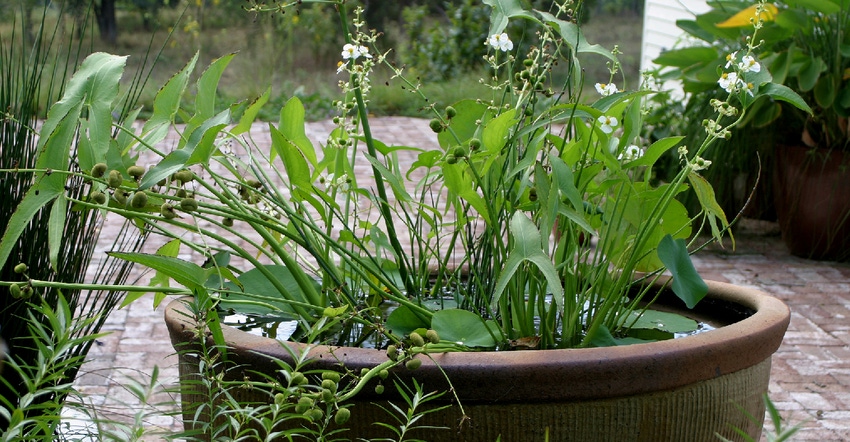December 17, 2020

There is a way to have garden beauty in the spring and summer that doesn’t require as much labor during the season — consider a container wetland garden.
There are five essential elements to any wetland garden planted in a container:
1. Container or planter construction. Containers come in dry-cast limestone, ceramic, steel or concrete and need to hold water to function for native wetland plants. These kinds of planters either lack a drain hole, or the hole is plugged with a rubber stopper smeared with silicone. Galvanized stock tanks can work because they have threaded drain plugs that make draining easy, although they look rustic.
Containers can crack if mishandled or left outside over the winter full of water. Place ceramic containers on something that will absorb the shock, such as a kneepad or floor pad, when moving into place.
2. Planter size. Planters need to be large enough to buffer evaporation during hot summer months. This is important to reduce maintenance because small pots will evaporate quickly and need topping off often. Large planters can go weeks between refills. At a minimum, select a planter that is 15 inches high by 30 inches wide. Remember, the bigger, the better.
3. Water requirements. Wetland container gardens have standing water at the surface and enough depth, around 6 inches or more. At this level, the garden can attract frogs that look for suitable places to lay eggs in spring. Since frogs may not appear every year, consider adding guppies in the spring, which also love to eat mosquito larvae. They aren’t big enough to eat pollywogs and die when water drops below 60 degrees F.
4. Plants selection. Use native emergent aquatic wetland species, ones that grow in shallow water, such as aquatic milkweed, pickerel weed, arrowhead, arrow arum, wild canna, yellow lotus, fragrant water lily, soft rush and chairmaker’s rush.
Wetland species like these look exotic, with broad or fine leaves, but are native in Missouri and parts of surrounding states. Any native emergent aquatic wetland species will do, even cattail!
5. Soil composition. Don’t use regular potting soil because its ingredients of peat moss and perlite float. Also, be careful with commercially available “topsoil” in bags, which is often mostly compost. This will make a huge mess.
You need 100% mineral-based topsoil, the kind that comes from a shovel full of your yard. Don’t worry if you think it has too much clay — wetland plants love clay soil. Also, many of these wetland species grow extremely large if given rich soil or fertilizer. Regular, abused suburban clay soil works best.
Plant small containers
In late April, lay soil 8 to 10 inches deep on the bottom of a low-profile planter (15 to 20 inches deep). Plant a wetland species of your choice, 10 inches apart if small, or farther apart if large. Start with smaller plants because large potted plants will float to the surface.
Cover the crown of each plant with an inch of topsoil and then an inch of gravel. Pea gravel will work, but a half-inch of river gravel is better. A collection of marbles or sea glass work too. The idea is to cover the plants with enough weight to hold them down until they root in.
Carefully fill the planter with water to prevent muddying the water. The water may be murky at first, but it will become clear in a few hours.
Deep container basics
For larger planters of 24 to 36 inches or deeper, add soil nearly to the top of a 10- to 16-inch-tall plastic pot. Plant wetland species, and then add 1 inch of gravel above the topsoil and inside the plastic pot.
Remember to allow 6 to 8 inches of open water at the top for tadpoles or guppies. The plants listed above will grow in water this deep. When selecting a planter, keep in mind that deep planters must have thick enough walls to support such a large volume of water.
Multiple pots per container
Some may consider using more than one plastic pot full of wetland plants inside a large planter. For that, place the pots in the planter, so that they loosely touch each other and the sides of the planter. For really deep planters, you may need to carefully place bricks or flagstone at the bottom to prop the pots up to a suitable height.
Using multiple plastic pots makes dismantling in fall much easier. Simply remove the plastic pots, and drain the water from the planter with a hose siphon. Then either turn the planter upside down or cover it to keep the rain out.
Wetland containers are replanted every year. The best time of year to buy a planter is in fall or winter when they go on sale, but be careful to avoid planters with hairline cracks.
Woodbury is a horticulturalist and curator of the Whitmire Wildflower Garden at Shaw Nature Reserve in Gray Summit, Mo. He also is an adviser to the Missouri Prairie Foundation’s Grow Native! program.
About the Author(s)
You May Also Like




